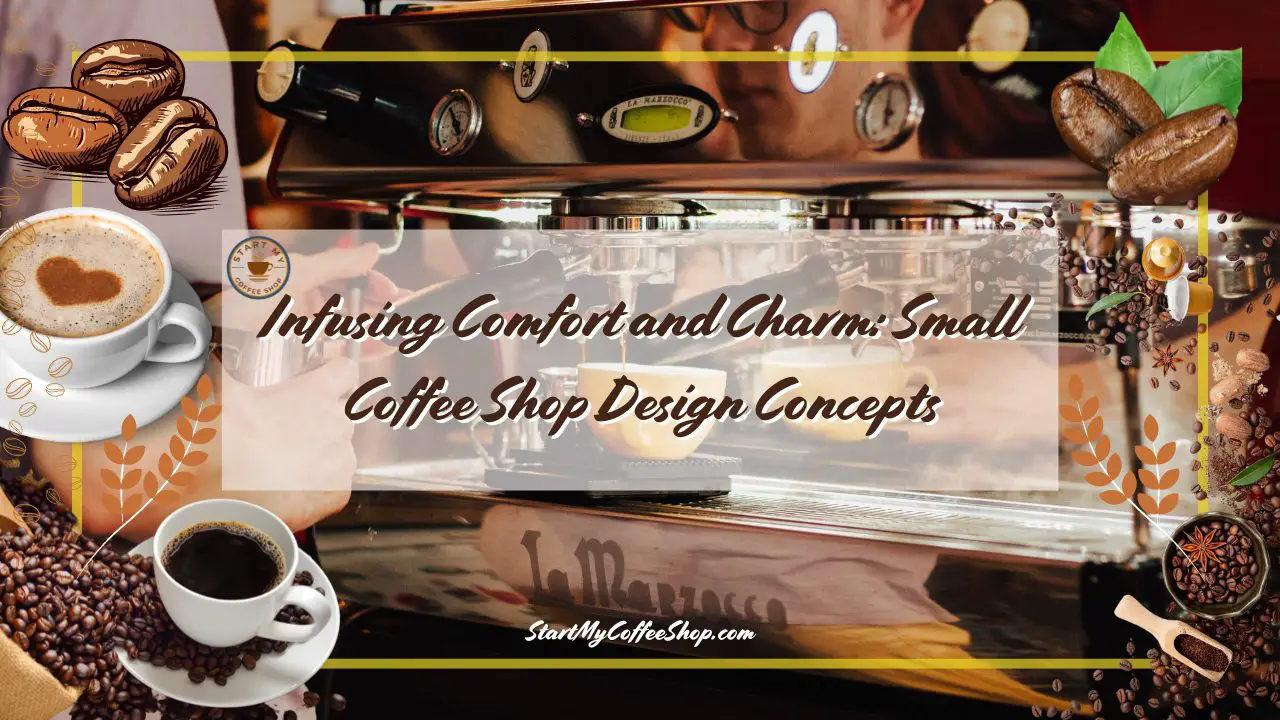When it comes to designing a coffee shop, it’s not just about the quality of the coffee beans or the menu offerings. The ambiance and atmosphere play a significant role in attracting and retaining customers.
Key factors to consider when designing a coffee shop for a comfortable and inviting atmosphere include seating arrangement, lighting, decor, color scheme, acoustics, layout flow, comfortable furniture, and incorporating natural elements.
In this article, I will explore some key factors to consider when designing a coffee shop, ensuring that customers feel welcomed and eager to return.
1. Seating Arrangement
 The seating arrangement in a coffee shop is a fundamental aspect that significantly contributes to creating a comfortable and inviting atmosphere. To ensure customer satisfaction, it is crucial to provide a variety of seating options that cater to different preferences and needs. A well-designed seating area can encourage customers to stay longer, fostering a sense of relaxation and enjoyment.
The seating arrangement in a coffee shop is a fundamental aspect that significantly contributes to creating a comfortable and inviting atmosphere. To ensure customer satisfaction, it is crucial to provide a variety of seating options that cater to different preferences and needs. A well-designed seating area can encourage customers to stay longer, fostering a sense of relaxation and enjoyment.
Consider incorporating a mix of seating styles such as cozy armchairs, comfortable sofas, communal tables, and bar stools. This diverse range of options allows customers to choose the seating arrangement that suits their mood and purpose.
Some customers may prefer a cozy corner with plush chairs, perfect for unwinding with a book or engaging in a private conversation. On the other hand, communal tables can facilitate social interactions and create a vibrant atmosphere, ideal for group gatherings or collaborative work sessions.
Creating different seating zones within the coffee shop can further enhance the overall experience. Quiet corners with softer lighting and secluded seating can provide a serene environment for customers seeking solitude or focused work. Vibrant communal areas with livelier decor and larger tables can foster a lively ambiance for socializing or networking.
By offering a variety of seating options and zones, coffee shop owners can cater to the diverse preferences of their customers, ensuring everyone feels comfortable and accommodated. This thoughtful approach to seating arrangement contributes to a positive and inviting atmosphere, enhancing the overall enjoyment of the coffee shop experience.
2. Lighting
 Lighting plays a crucial role in setting the mood and ambiance of a coffee shop. It has the power to create a welcoming and comfortable atmosphere that encourages customers to linger and enjoy their time. When designing the lighting scheme, it is important to avoid harsh, bright lights that can be overwhelming or create a clinical and impersonal environment.
Lighting plays a crucial role in setting the mood and ambiance of a coffee shop. It has the power to create a welcoming and comfortable atmosphere that encourages customers to linger and enjoy their time. When designing the lighting scheme, it is important to avoid harsh, bright lights that can be overwhelming or create a clinical and impersonal environment.
Instead, opt for warm and inviting lighting that evokes a cozy and intimate feel. Soft, diffused lighting sources like pendant lights or wall sconces can help achieve this effect. Consider using warm white or amber-toned bulbs to create a soothing and pleasant glow throughout the space.
To add versatility to the ambiance, incorporate dimmers that allow you to adjust the lighting levels according to different times of the day or specific events. For instance, during the mornings, you might want brighter lighting to create an energizing atmosphere, while in the evenings, dimmer and softer lighting can promote relaxation.
Maximizing natural light is highly desirable in a coffee shop. If possible, make use of large windows and skylights to invite ample daylight into the space. Natural light has a positive effect on people’s mood and can make the environment feel fresh and airy. However, it’s important to consider potential glare or excessive brightness, so window treatments like blinds or curtains can help regulate the incoming light.
Supplementing natural light with soft, warm artificial lighting sources is necessary for evenings or when natural light is limited. Choose fixtures that emit a warm glow and are in harmony with the overall design theme of the coffee shop. The goal is to create a balance between natural and artificial lighting, ensuring a comfortable and inviting atmosphere throughout the day.
3. Decor and Color Scheme
 The decor and color scheme of a coffee shop play a significant role in creating a welcoming and inviting atmosphere for customers. It is important to choose a cohesive theme that aligns with the coffee shop’s identity and desired ambiance, whether it’s rustic, modern, or eclectic.
The decor and color scheme of a coffee shop play a significant role in creating a welcoming and inviting atmosphere for customers. It is important to choose a cohesive theme that aligns with the coffee shop’s identity and desired ambiance, whether it’s rustic, modern, or eclectic.
To add warmth and texture to the space, consider incorporating natural materials such as wood, exposed brick, or stone. These elements not only create a visually appealing environment but also provide a sense of authenticity and comfort. The use of natural materials can evoke a connection to nature, which can have a calming effect on customers.
Equally important is the selection of a suitable color palette. Earthy tones, such as warm browns, soft greens, or soothing blues, can create a serene environment that promotes relaxation. These colors have a comforting and inviting quality that can make customers feel at ease. However, the choice of colors should also align with the coffee shop’s branding and identity.
Attention to detail is crucial in creating a visually interesting and engaging space. Incorporate artwork that reflects the coffee shop’s character and adds personality to the walls. Consider displaying local artists’ work or coffee-related illustrations to create a unique and inviting atmosphere. Plants can also play a vital role in adding vibrancy and life to the space. Introduce potted plants or hanging greenery to infuse a natural element and create a fresh and welcoming ambiance.
In addition to decor elements, consider incorporating decorative elements like comfortable seating cushions, cozy blankets, or unique lighting fixtures that add an extra touch of charm and comfort to the space. These small details can contribute to creating a memorable and inviting experience for customers.
Read more about Cost to Open Scooter’s Coffee Shop: Mapping Out the Financial Landscape
4. Acoustics
The acoustics of a coffee shop play a crucial role in shaping the overall customer experience. Excessive noise levels can be a major deterrent, making it difficult for customers to have conversations or concentrate on their work. To create a comfortable and inviting auditory environment, it is important to consider sound-absorbing materials and appropriate background music.
Incorporating sound-absorbing materials throughout the coffee shop helps minimize echo and reverberation, effectively reducing the overall noise level. Carpets or rugs on the floors, curtains or drapes on windows, and acoustic panels on walls can all contribute to absorbing and dampening sound waves. These materials help create a more intimate and controlled soundscape, allowing customers to enjoy their conversations without competing with excessive noise.
Background music can enhance the ambiance of a coffee shop and provide a pleasant auditory backdrop. However, it’s crucial to ensure that the volume is set at an appropriate level. The music should enhance the atmosphere without overpowering conversations or disturbing concentration. Strike a balance by keeping the volume low enough to allow customers to comfortably engage in conversations or focus on their tasks, while still providing a soothing and enjoyable musical backdrop.
Consider the genre and tempo of the music as well, as it can influence the overall atmosphere. Soft instrumental melodies, gentle jazz tunes, or mellow acoustic tracks can create a relaxed and inviting environment. Avoid music with heavy bass or loud, energetic beats that can disrupt the desired ambiance of a coffee shop.
Regularly monitor the noise levels in the coffee shop to ensure they remain within acceptable limits. Pay attention to customer feedback and adjust the acoustics and music accordingly. By creating a comfortable auditory environment, coffee shop owners can foster a welcoming atmosphere where customers can enjoy their coffee, engage in conversations, or focus on their work without being overwhelmed by excessive noise.
5. Layout Flow
An efficient layout flow is a critical aspect in designing a coffee shop that provides a seamless and enjoyable customer experience. The space should be designed in a way that allows customers to navigate effortlessly from the entrance to the ordering counter, seating areas, and amenities.
To ensure a smooth flow, it is essential to avoid overcrowding or congested pathways. Adequate space should be allocated for customers to move freely without feeling cramped or uncomfortable. Consider the expected foot traffic and arrange the furniture and fixtures accordingly to provide clear pathways and easy access to different areas of the coffee shop.
Strive for a balanced distribution of space throughout the coffee shop. Arrange tables and seating areas in a way that allows for comfortable distances between them. This not only enhances the comfort of customers but also promotes better traffic flow. Customers should be able to move around without obstruction and have ample space to pull out chairs or pass by other customers.
Well-defined sections for ordering, pickup, and seating contribute to the overall efficiency of the coffee shop. Clearly mark these areas to guide customers and minimize confusion. Designate a dedicated space for the ordering counter, ensuring it is easily visible and accessible from the entrance. Create a designated area for customers to pick up their orders, separate from the seating areas, to avoid congestion and maintain a smooth flow of movement.
Consider the placement of amenities such as condiment stations, restrooms, and self-service areas. Position them strategically so that they are easily accessible to customers without causing congestion or obstructing the flow of traffic.
6. Comfortable Furniture
Investing in comfortable furniture is a key factor in ensuring customer satisfaction in a coffee shop. The chairs and sofas should provide adequate support and cushioning to allow customers to relax and enjoy their time.
Consider ergonomic designs that promote good posture, particularly for customers who may spend extended periods in the coffee shop, such as those working on laptops or engaging in long conversations.
Choosing the right upholstery materials is also crucial. Opt for fabrics that are not only aesthetically pleasing but also durable and easy to clean. Spills and stains are inevitable in a coffee shop environment, so selecting materials that can withstand regular use and are easy to maintain is essential. This will help keep the furniture looking fresh and inviting for customers.
A great coffee shop design combines style with comfort. The furniture should not only be comfortable but also visually appealing, complementing the overall aesthetic of the space.
Consider the coffee shop’s theme and ambiance when selecting furniture styles and designs. Whether it’s modern, rustic, or eclectic, the furniture should seamlessly integrate into the overall design concept, creating a cohesive and welcoming environment.
7. Natural Elements
Incorporating natural elements into a coffee shop design can provide a refreshing and revitalizing atmosphere. Plants, whether small potted ones or hanging greenery, have the power to add a sense of tranquility and life to the space. Not only do they contribute to the aesthetic appeal, but they also improve air quality by acting as natural air purifiers.
In addition to plants, integrating natural light is crucial for creating a welcoming ambiance. Large windows, skylights, or even outdoor seating areas can establish a connection with the outside environment, allowing customers to enjoy their coffee while feeling more connected to nature. Natural light has a positive effect on people’s mood and well-being, making the coffee shop experience more enjoyable.
The presence of natural elements creates a harmonious and organic atmosphere, promoting a sense of calmness and relaxation. The sight of greenery and the influx of natural light can have a therapeutic effect, contributing to a more serene and inviting environment for customers to unwind and savor their coffee.
Summary
Designing a coffee shop that exudes comfort and invites customers to stay requires careful consideration of various factors. From seating arrangement and lighting to decor, color scheme, and acoustics, each element contributes to creating an atmosphere that customers will find welcoming and enjoyable.
By paying attention to these key factors, coffee shop owners can create a cozy haven that not only serves excellent coffee but also offers a warm and inviting ambiance that keeps customers coming back for more.
So, grab your favorite brew, embrace creativity, and design a coffee shop that becomes a cherished community space for coffee lovers and friends alike.
Frequently Asked Questions
1. Q: How can I make my coffee shop feel cozy and comfortable?
A: To create a cozy atmosphere, focus on factors like warm lighting, comfortable seating options, soft background music, and a welcoming color scheme.
2. Q: What role does the layout play in designing a comfortable coffee shop?
A: An efficient and well-thought-out layout ensures smooth customer flow and comfortable seating arrangements. A well-planned layout enhances customer experience and contributes to a relaxed atmosphere.
3. Q: How can I control noise levels in my coffee shop?
A: Incorporate sound-absorbing materials like carpets, curtains, or acoustic panels to minimize echo and reverberation. Play background music at an appropriate volume, and consider designating quiet areas for customers seeking a quieter space to work or have conversations.
To learn more on how to start your own coffee shop checkout my startup documents here
Please note: This blog post is for educational purposes only and does not constitute legal advice. Please consult a legal expert to address your specific needs.

Hi! I’m Shawn Chun
My adventure in coffee began when I first launched my first coffee shop back in the early 2000s. I had to figure out so many things on my own and to make it worse within 2 years of opening two large corporate coffee chains moved in just blocks away from me!
As I saw smaller and even some larger coffee shops in the neighborhood slowly lose customers to these giant coffee chains and slowly close up shop, I knew that I had to start getting creative…or go out of business.
I (like you may be) knew the coffee industry well. I could make the best latte art around and the foam on my caps was the fluffiest you have ever seen. I even had the best state-of-the-art 2 group digital Nuova Simonelli machine money could buy. But I knew that these things alone would not be enough to lure customers away from the name brand established coffee shops.
Eventually, through lots of trial and error as well as perseverance and creativity I did find a way to not only survive but also thrive in the coffee/espresso industry even while those corporate coffee chains stayed put. During those years I learned to adapt and always faced new challenges. It was not always easy, however, in the end, I was the sole survivor independent coffee shop within a 10-mile radius of my location. Just two corporate coffee chains and I were left after that year. All told the corporate coffee chains took down over 15 small independent coffee shops and kiosks and I was the last one standing and thriving.
Along the years I meet others with the same passion for coffee and I quickly learned that it is not only “how good a barista is” that makes a coffee shop successful, but the business side of coffee as well.
Hence why I started this website you are on now. To provide the tools and resources for up and coming coffee shop owners to gain that vital insight and knowledge on how to start a coffee shop successfully.
Stick around, browse through my helpful blog and resources and enjoy your stay! With lots of LATTE LOVE!
Shawn






